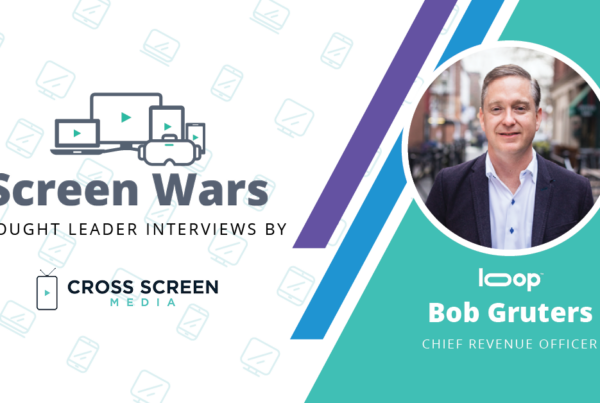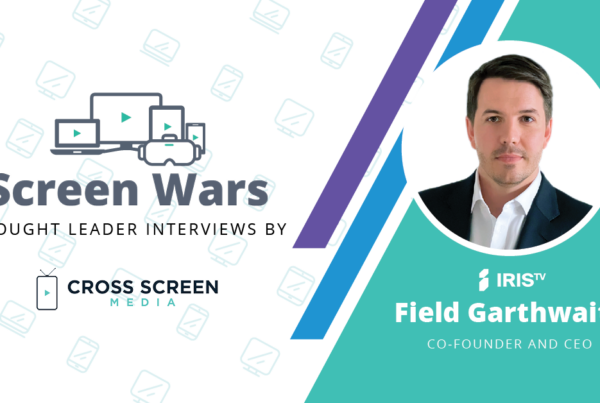Michael Schoen, SVP and GM of Marketing Solutions at Neustar, joins Cross Screen Media CEO Michael Beach to share his thoughts on what the future of identity looks like as consumer privacy continues to evolve, and how attribution will transform the video advertising industry, in our latest Screen Wars Thought Leader Interview. Watch the interview here and read the full transcript below!
Michael Beach: Michael. Thanks for joining us.
Michael Schoen: Thank you. Happy to be here.
MB: Excellent. We like to start all of our guests off with the same icebreaker. What was your first job and what lessons did you take away that you’ve applied to your career?
MS: Well, my very first job was as a short-order chef at a Bun and Burger at the Brunswick Square Mall in New Jersey, but I don’t think that’s what you mean. So, my first real job was with Accenture, which was still known as Anderson Consulting. I was in the advanced technology group, which really meant anything that wasn’t dealing with mainframes.
I think I took away two core lessons. First was the value of being able to simplify a problem, both in terms of being able to get at the core of the issue and actually being able to resolve the problem. More importantly, I think it was the aid it provided in being able to effectively communicate with a broader team. So being able to take a challenging, complex issue, break it down to its component pieces and communicate that back was an important lesson for me.
The second was the value of mentorship. I was fortunate to find at my first few client engagements senior leaders who took a real interest in me, provided constructive feedback, and helped guide me in my career. I think in my own career, I’ve aimed to pay that forward and identify folks who I can be helpful to and ensure that they are on a productive path for their own future.
MB: Speaking of taking something complicated and making it simple, that’s a perfect lead-in to how you got started in the marketing technology space.
MS: Yeah, certainly. After leaving Accenture, I joined Warner Music Group for a few years. After that, I joined a small startup in LA in the user-contributed content space. That company was acquired in 2000 by LookSmart, which at the time was a leading search engine that powered Microsoft’s internet directory. That really brought me into the marketing technology space.
Over my time at LookSmart, we developed it into a pioneer in the paid search space, so I got really steeped in search. After LookSmart, I joined IPG Mediabrands and that gave me a much broader exposure, both in terms of the various aspects of marketing and ad tech technology, and also broad exposure to a lot of clients that we worked with directly.
MB: That’s great. Well, I guess before we dive in, we’ve got a bunch of questions from our community. Can you give us an idea of what Neustar is and how they fit the advertising ecosystem?
MS: Neustar can be challenging for folks to understand because we don’t fit simply into just one box. Neustar really runs the gamut. I think the thing that ties all of Neustar’s solutions together is Neustar’s unique position in identity and analytics.
Neustar provides a broad set of solutions through unified identity and unified analytics, which are really about a set of solutions that help brands understand their customers from an omni-channel perspective. Then being able to understand from an analytics perspective, the impact of their marketing investments and how to optimize them.
MB: Excellent. Well, we come at this from a heavy focus on video, probably 80% of our community is in the video space. Whether it’s announcements from Apple with the iPhone or what’s going to happen with third-party cookies or unified identity, how do you think that’s going to play out in the broader video and TV ecosystem? 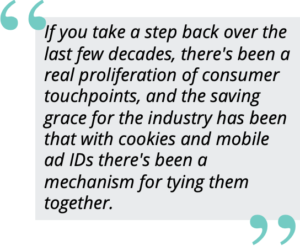
MS: It certainly creates a real challenge. If you take a step back over the last few decades, there’s been a real proliferation of consumer touchpoints, and the saving grace for the industry has been that with cookies and mobile ad IDs there’s been a mechanism for tying them together. I think it can feel to many folks that the bottom is falling out now with Apple shifting to an opt-in model, and Google set to deprecate that third-party cookie early next year.
Neustar’s approach has always been founded in our authoritative identity. Neustar has the ability to understand consumers from an offline perspective. The way we’ve approached traditional TV, for example, has never been reliant on any of those digital identifiers. Certainly from an analytics perspective, the way that we incorporate linear TV exposure into analytics models, both through marketing mix and multi-touch attribution, does not rely on any of the digital identifiers.
We’ve taken a broad set of approaches as we think about how brands are being challenged. We brought it to market with something we called Neustar Fabrick. With Fabrick we are combining our offline identity solution, our ability to understand consumers from the perspective of name, address, phone number, email address, combined with a set of solutions that really tackle the problem in the digital space.
Most brands are really focused on spending their digital investments within the walled gardens, and so we’ve built some unique integrations with folks like Facebook, Pinterest, Twitter, LinkedIn, Amazon, and others that enabled Neustar to incorporate the impact of ad exposures in those environments.
Often with techniques that leverage advanced differential privacy solutions to ensure that, while we’re able to incorporate the incremental impact of this marketing exposure, we do it in a way that does not expose any private user information outside the context of the walled gardens.
We have also developed a set of clean room solutions that allow us to partner with publishers to provide the opportunity for brands and publishers to collaborate on data in a way that ensures that each party’s data remains well-protected.
Then finally, we are a partner with solutions like the Chrome Privacy Sandbox. Neustar made a proposal as part of the W3C working group, known as PeLICAn. Folks who are familiar with what Google is doing, the Chrome Privacy Sandbox, recognize that all of the proposals have bird names. We had to go with PeLICAn.
PeLICAn is an approach that will enable Neustar and others to incorporate exposures that can be measured via the Chrome browser in a way, leveraging differential privacy that does not expose user level information, but still allows us to incorporate advanced MTA models, the impact of those exposures.
Finally, there’s one aspect of this space that has gotten a lot of attention, which is what we refer to as the programmatic IDs and identified contacts. That’s where publishers have gotten consumers to provide some form of identity, typically an email address, and that provides the opportunity for identity providers to provide an ID that can be used to tie exposures across multiple publishers.
LiveRamp has proposed their ATS solution, The Trade Desk innovated with UID 2.0 that’s now being handed over to pre-bid, and Neustar has a similar solution. We refer to it as Fabrick ID, which is part of the overall Fabrick solution set. One unique thing we’re doing here is that Fabrick is fully interoperable with both ATS and UID.
We’re not requiring that either brands or publishers make a bet on which of these programmatic ideas will be the “winner.” It’s really about ensuring that we’re providing maximum reach. We’ll provide some incremental reach above some of those other solutions.
MB: The world’s gotten much more complicated in the last 10 years, and needing to have multiple identity partners to operate in an environment where you’re already dealing with multiple walled gardens would be quite the challenge. A topic that’s coming up almost daily for our customer base is attribution and business outcomes. Obviously, it’s been around in digital for display and social and search for forever. What do you see happening to video in the linear space, and what’s that going to look like in the next couple of years?
MS: From an attribution perspective?
MB: Yeah or what do you see people doing beyond just reaching frequency or age and gender? It seems like we’re getting out of audience targeting or audience measurement alone being the new metric, and that people are wanting to get more mid- and down-funnel metrics on video.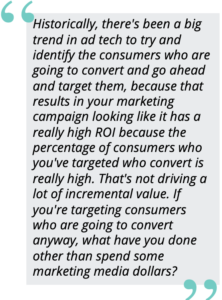
MS: Yeah, certainly, that’s the case. One of the ways in which Neustar has been helping brands is by providing a unified approach to video. So not thinking about digital video and linear TV as being separate channels, but really part of a whole and looking at them holistically in terms of how they’re actually impacting consumer propensity to convert.
Neustar’s unified analytics approach is holistic, and it combines traditional marketing mix techniques with multi-touch attribution. That’s important because with MTA’s techniques we’re able to incorporate the differences in consumer propensities between audiences.
There may be some sets of your customer base that are likely to convert that have a propensity toward your brand already. There are other aspects of your audience that are less likely to convert, and the impact of the video channel may be different for those different audiences.
Marketing mix is still important because there are endemic factors in the industry. The economy may be impacting your purchases, and being able to incorporate those factors is critical. One of the things that’s unique about Neustar’s approach is not only do we incorporate the impact of linear TV through marketing mix, but through partnerships with folks like iSpot, we’re also incorporating linear TV exposure into MTA models right alongside digital video and connected TV solutions.
Our approach is really focused on understanding the incremental impact of marketing. It’s not just about being able to identify folks who were going to convert anyway, but really being able to understand the incremental value of your marketing investment.
That feeds back into the topic of targeting. When you’re running those, in particular digital video campaigns, being able to build an audience of the consumers who are most likely to be influenceable by marketing activities drives a lot of value.
Historically, there’s been a big trend in ad tech to try and identify the consumers who are going to convert and go ahead and target them, because that results in your marketing campaign looking like it has a really high ROI because the percentage of consumers who you’ve targeted who convert is really high.
That’s not driving a lot of incremental value. If you’re targeting consumers who are going to convert anyway, what have you done other than spend some marketing media dollars? Our approach is really to leverage our analytics, to help predictably build audiences who you can incrementally use to drive business impact.
MB: Excellent. I think that’s going to be a big trend. Three or four years ago, it was not something we were getting asked about a lot on the video side. Today, it’s almost become table stakes with both the buy and sell side, which is pretty fascinating. I have a couple more questions on the identity front. One, as you look forward five years, what do you think the world looks like on the identity side? Then, what do you expect your customers to keep doing, start doing, and stop doing?
MS: I think identity in marketing is becoming ever more important. Brands, especially now, recognize the importance of building direct, meaningful, long-term relationships directly with consumers. These recent changes we’re seeing in the digital ecosystem underscore that because there’s the risk of being disintermediated by some of these technology providers.
The only way for brands to withstand that in the long term is to ensure that they’ve got a direct relationship. Overall, brands are certainly going to be making more investments in those relationships and then an investment in enterprise identity to help maximize the value.
That’s certainly an area where Neustar’s been focused on with our unified identity solution, which is really about providing a solution for that enterprise identity infrastructure problem. With unified identity, what Neustar is doing is helping to ensure that brands get the most leverage from those investments in first-party data, which can include solving good hygiene problems and ensuring that the data that the brand collects from consumers is correct and kept up to date and it can be duplicated.
It’s also about enriching that data to provide additional attributes to maximize the value and then providing solutions for activation. Integrations across the ecosystem so that the brands are able to actually connect with consumers across all channels.
In terms of what brands are going to stop doing, I think it’s well past time that brands really stop with things like last-click attribution. I may still be optimistic, but I’m hoping that five years from now, that’s no longer happening.
Then brands are not still falling into what I call the retargeting trap, where retargeting looks great because it seems to show really high marketing ROI, but it’s only because you’re giving all the value to the last click in the value chain.
MB: I’ve got a theory on this, but would love to hear your thoughts. Do you think that’s more because the marketer is so reliant on reporting and analytics from the media seller? Obviously, if you’re a media seller the last click looks great, you’re going to push that, or what do you think the driver is?
MS: It’s certainly true that last click attribution as provided by individual media channels is incredibly self-serving. It is the view that allows each media channel to put its best foot forward. To be fair, it’s also the simplest solution in a world in which technology has gotten hard, and in many cases, continues to get harder. It’s easy to fall back on the low-hanging fruit.
Folks may realize that in Google’s initial announcement of the Chrome Privacy Sandbox, the one marker that’s been provided for attribution is last-click, and again, you can argue that that is self-serving, but it’s also the approach that is technically the easiest to provide. But it is incredibly important that brands recognize that the investment in being able to implement a more sophisticated solution is worth it. Because the value of marketing needs to be measured in the incremental impact it has in terms of driving actual new sales.
MB: Absolutely. What’s one area that you think has the most value that really no one’s talking about it in the identity space?
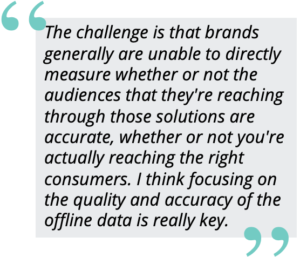 MS: I think it’s the cleanliness of offline datasets. I think there’s been a lot of focus on being able to maximize the online digital reach of your first-party data. I think the challenge is that brands generally are unable to directly measure whether or not the audiences that they’re reaching through those solutions are accurate, whether or not you’re actually reaching the right consumers. I think focusing on the quality and accuracy of the offline data is really key.
MS: I think it’s the cleanliness of offline datasets. I think there’s been a lot of focus on being able to maximize the online digital reach of your first-party data. I think the challenge is that brands generally are unable to directly measure whether or not the audiences that they’re reaching through those solutions are accurate, whether or not you’re actually reaching the right consumers. I think focusing on the quality and accuracy of the offline data is really key.
I think the other challenge, which we touched on at the beginning of the conversation, is a lot of brands have pieced together solutions across multiple providers over time. It has resulted in what we now refer to as data chaos, where if you’re working with multiple providers of identity solutions across activation and onboarding and data hygiene, you may find that you have made improvements in that data across those individual silos.
But you’re not maximizing the value of your investment because there’s a significant amount of data loss involved. If across each of your marketing channels, you’re working with a different identity provider and there’s a loss of fidelity that occurs.
MB: Have you seen the quality of the offline data improve in recent years, or has it deteriorated? What we find with our customer base is that 10 years ago, it was very rare that they were combining their CRM data with offline consumer data from multiple providers, but it’s much more common today for us to find an agency or marketer that’s trying to combine a lot of this on their own. Has that helped or hurt, or what have you seen overall in the cleanliness of the offline data?
MS: Yeah, we’re certainly seeing that same trend. Brands recognize that they need to be pulling together all aspects of their first-party relationship with consumers, and I think that the long-term trend is toward improving the quality of that data.
There is that short-term challenge that the data they’ve collected in these individual channels often doesn’t agree and is not connected. It necessitates the need for working with an enterprise identity provider. We worked recently with a large electronics retailer that did an audit of their own internal systems and recognized that across all the different touchpoints, they might actually recognize an individual consumer with 46 different identifiers, which is just insane.
Obviously, it gets in the way of being able to maximize the value of their relationship with that individual consumer. Identifying that as a challenge and then making a real investment in solving for it is certainly a requirement today.
MB: Excellent. Well, we’ll get you out of here on one more question that we ask all our guests, if you could get your entire team to read one book right now, what would it be and why?
MS: Over the last year, Neustar’s made a big investment in a diversity equity and inclusion initiative, and as part of that program, we’ve actually just started off a CEO book club to help drive conversations within the organization.
The first book that the team is tackling is Vanishing Half by Brit Bennett. It’s historical fiction, starts in the 1950s about twin sisters growing up in a small, Southern, black community. The twins run away at age 16 and end up with pretty divergent paths, and it’s a story of race, gender, sexuality, and the complexities of identity.
It’s an award-winning book. Apparently, HBO is now developing a limited series from the novel. Incredibly well-written, compelling story, and certainly encourage folks on my team to read it because we are going to be using that to tee up some challenging conversations with the organization that are incredibly important for us.
MB: Great recommendation. Well, Michael, I’ve loved the conversation. Anything else we missed?
MS: Again, just underscoring the challenging times that we face today as marketers and the role that solutions like identity and analytics play in charting the path forward.
MB: Excellent. Well, I’m grateful for your time, and I know our community’s going to love the conversation, so thank you.
See the rest of the Screen Wars Thought Leader Interview series here!
Michael Schoen, SVP and GM of Marketing Solutions at Neustar
Michael Schoen is currently the SVP and GM of Marketing Solutions at Neustar. Schoen leads product, market, and commercial strategy for Neustar’s customer identity, experience, and analytics products including multi-touch attribution (MTA), marketing mix modeling (MMM), consumer data management and media activation (IDMP), as well as data onboarding and identity resolution solutions. Schoen recently spearheaded the launch of Neustar Fabrick ™ , a next generation solution that future proofs brands, publishers, and platforms in a privacy-first, post-cookie world.
Prior to joining Neustar in 2014, Schoen was the EVP, Product at Cadreon, IPG’s cross-channel audience measurement, management and buying platform. He was responsible for driving the product strategy, development, and technology partnerships that enabled Cadreon’s offerings across all addressable media. Schoen was also the GM, Advertising Platforms and VP of Product and Technology at Looksmart. Michael received his AB in Computer Science from Harvard University, and MBA from UCLA Anderson School of Management.
Cross Screen Media is a marketing analytics and software company empowering marketers to plan, activate, and measure Connected TV and audience-driven Linear TV advertising at the local level. Our closed-loop solutions help brands, agencies, and networks succeed in the Convergent TV space. For more information, visit CrossScreenMedia.com.


